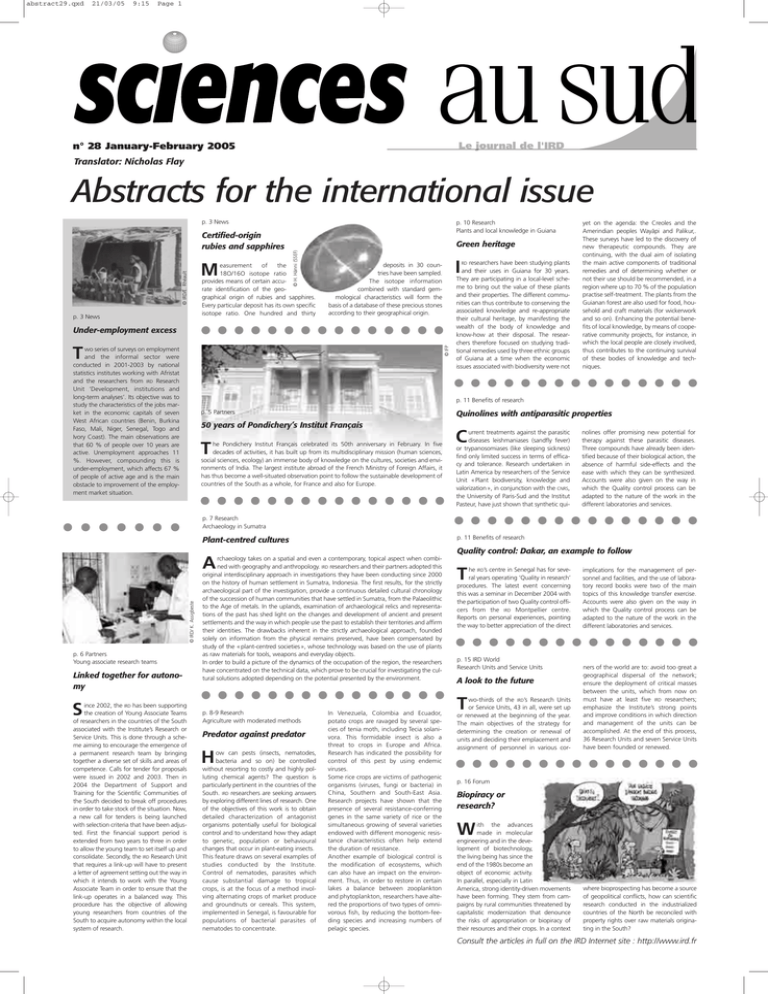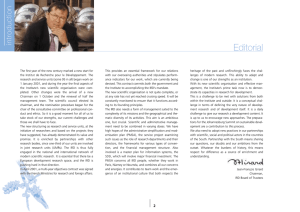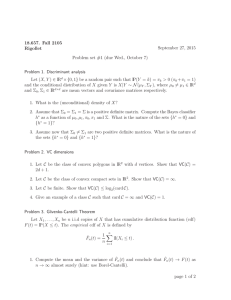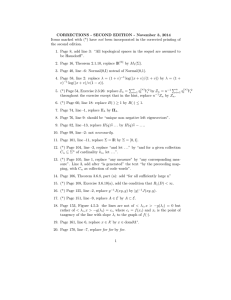M Le journal de l'IRD n° 28 January-February 2005 Translator: Nicholas Flay
advertisement

abstract29.qxd 21/03/05 9:15 Page 1 Le journal de l'IRD n° 28 January-February 2005 Translator: Nicholas Flay Abstracts for the international issue p. 3 News M Green heritage © H. Hänni (SSEF) Certified-origin rubies and sapphires p. 10 Research Plants and local knowledge in Guiana © IRD/É. Rhéault easurement of the 18O/16O isotope ratio provides means of certain accurate identification of the geographical origin of rubies and sapphires. Every particular deposit has its own specific isotope ratio. One hundred and thirty p. 3 News I deposits in 30 countries have been sampled. The isotope information combined with standard gemmological characteristics will form the basis of a database of these precious stones according to their geographical origin. © IFP Under-employment excess T wo series of surveys on employment and the informal sector were conducted in 2001-2003 by national statistics institutes working with Afristat and the researchers from IRD Research Unit ‘Development, institutions and long-term analyses’. Its objective was to study the characteristics of the jobs market in the economic capitals of seven West African countries (Benin, Burkina Faso, Mali, Niger, Senegal, Togo and Ivory Coast). The main observations are that 60 % of people over 10 years are active. Unemployment approaches 11 %. However, compounding this is under-employment, which affects 67 % of people of active age and is the main obstacle to improvement of the employment market situation. researchers have been studying plants and their uses in Guiana for 30 years. They are participating in a local-level scheme to bring out the value of these plants and their properties. The different communities can thus contribute to conserving the associated knowledge and re-appropriate their cultural heritage, by manifesting the wealth of the body of knowledge and know-how at their disposal. The researchers therefore focused on studying traditional remedies used by three ethnic groups of Guiana at a time when the economic issues associated with biodiversity were not RD yet on the agenda: the Creoles and the Amerindian peoples Wayãpi and Palikur,. These surveys have led to the discovery of new therapeutic compounds. They are continuing, with the dual aim of isolating the main active components of traditional remedies and of determining whether or not their use should be recommended, in a region where up to 70 % of the population practise self-treatment. The plants from the Guianan forest are also used for food, household and craft materials (for wickerwork and so on). Enhancing the potential benefits of local knowledge, by means of cooperative community projects, for instance, in which the local people are closely involved, thus contributes to the continuing survival of these bodies of knowledge and techniques. p. 11 Benefits of research p. 5 Partners Quinolines with antiparasitic properties 50 years of Pondichery’s Institut Français T he Pondichery Institut Français celebrated its 50th anniversary in February. In five decades of activities, it has built up from its multidisciplinary mission (human sciences, social sciences, ecology) an immense body of knowledge on the cultures, societies and environments of India. The largest institute abroad of the French Ministry of Foreign Affairs, it has thus become a well-situated observation point to follow the sustainable development of countries of the South as a whole, for France and also for Europe. C urrent treatments against the parasitic diseases leishmaniases (sandfly fever) or trypanosomiases (like sleeping sickness) find only limited success in terms of efficacy and tolerance. Research undertaken in Latin America by researchers of the Service Unit « Plant biodiversity, knowledge and valorization », in conjunction with the CNRS, the University of Paris-Sud and the Institut Pasteur, have just shown that synthetic qui- nolines offer promising new potential for therapy against these parasitic diseases. Three compounds have already been identified because of their biological action, the absence of harmful side-effects and the ease with which they can be synthesized. Accounts were also given on the way in which the Quality control process can be adapted to the nature of the work in the different laboratories and services. p. 7 Research Archaeology in Sumatra p. 11 Benefits of research Plant-centred cultures Quality control: Dakar, an example to follow © IRD/ K. Assigbeste A p. 6 Partners Young associate research teams Linked together for autonomy S ince 2002, the IRD has been supporting the creation of Young Associate Teams of researchers in the countries of the South associated with the Institute’s Research or Service Units. This is done through a scheme aiming to encourage the emergence of a permanent research team by bringing together a diverse set of skills and areas of competence. Calls for tender for proposals were issued in 2002 and 2003. Then in 2004 the Department of Support and Training for the Scientific Communities of the South decided to break off procedures in order to take stock of the situation. Now, a new call for tenders is being launched with selection criteria that have been adjusted. First the financial support period is extended from two years to three in order to allow the young team to set itself up and consolidate. Secondly, the IRD Research Unit that requires a link-up will have to present a letter of agreement setting out the way in which it intends to work with the Young Associate Team in order to ensure that the link-up operates in a balanced way. This procedure has the objective of allowing young researchers from countries of the South to acquire autonomy within the local system of research. rchaeology takes on a spatial and even a contemporary, topical aspect when combined with geography and anthropology. IRD researchers and their partners adopted this original interdisciplinary approach in investigations they have been conducting since 2000 on the history of human settlement in Sumatra, Indonesia. The first results, for the strictly archaeological part of the investigation, provide a continuous detailed cultural chronology of the succession of human communities that have settled in Sumatra, from the Palaeolithic to the Age of metals. In the uplands, examination of archaeological relics and representations of the past has shed light on the changes and development of ancient and present settlements and the way in which people use the past to establish their territories and affirm their identities. The drawbacks inherent in the strictly archaeological approach, founded solely on information from the physical remains preserved, have been compensated by study of the « plant-centred societies », whose technology was based on the use of plants as raw materials for tools, weapons and everyday objects. In order to build a picture of the dynamics of the occupation of the region, the researchers have concentrated on the technical data, which prove to be crucial for investigating the cultural solutions adopted depending on the potential presented by the environment. p. 8-9 Research Agriculture with moderated methods Predator against predator H ow can pests (insects, nematodes, bacteria and so on) be controlled without resorting to costly and highly polluting chemical agents? The question is particularly pertinent in the countries of the South. IRD researchers are seeking answers by exploring different lines of research. One of the objectives of this work is to obtain detailed characterization of antagonist organisms potentially useful for biological control and to understand how they adapt to genetic, population or behavioural changes that occur in plant-eating insects. This feature draws on several examples of studies conducted by the Institute. Control of nematodes, parasites which cause substantial damage to tropical crops, is at the focus of a method involving alternating crops of market produce and groundnuts or cereals. This system, implemented in Senegal, is favourable for populations of bacterial parasites of nematodes to concentrate. In Venezuela, Colombia and Ecuador, potato crops are ravaged by several species of tenia moth, including Tecia solanivora. This formidable insect is also a threat to crops in Europe and Africa. Research has indicated the possibility for control of this pest by using endemic viruses. Some rice crops are victims of pathogenic organisms (viruses, fungi or bacteria) in China, Southern and South-East Asia. Research projects have shown that the presence of several resistance-conferring genes in the same variety of rice or the simultaneous growing of several varieties endowed with different monogenic resistance characteristics often help extend the duration of resistance. Another example of biological control is the modification of ecosystems, which can also have an impact on the environment. Thus, in order to restore in certain lakes a balance between zooplankton and phytoplankton, researchers have altered the proportions of two types of omnivorous fish, by reducing the bottom-feeding species and increasing numbers of pelagic species. T he IRD’s centre in Senegal has for several years operating ‘Quality in research’ procedures. The latest event concerning this was a seminar in December 2004 with the participation of two Quality control officers from the IRD Montpellier centre. Reports on personal experiences, pointing the way to better appreciation of the direct p. 15 IRD World Research Units and Service Units A look to the future T wo-thirds of the IRD’s Research Units or Service Units, 43 in all, were set up or renewed at the beginning of the year. The main objectives of the strategy for determining the creation or renewal of units and deciding their emplacement and assignment of personnel in various cor- implications for the management of personnel and facilities, and the use of laboratory record books were two of the main topics of this knowledge transfer exercise. Accounts were also given on the way in which the Quality control process can be adapted to the nature of the work in the different laboratories and services. ners of the world are to: avoid too great a geographical dispersal of the network; ensure the deployment of critical masses between the units, which from now on must have at least five IRD researchers; emphasize the Institute’s strong points and improve conditions in which direction and management of the units can be accomplished. At the end of this process, 36 Research Units and seven Service Units have been founded or renewed. p. 16 Forum Biopiracy or research? W ith the advances made in molecular engineering and in the development of biotechnology, the living being has since the end of the 1980s become an object of economic activity. In parallel, especially in Latin America, strong identity-driven movements have been forming. They stem from campaigns by rural communities threatened by capitalistic modernization that denounce the risks of appropriation or biopiracy of their resources and their crops. In a context where bioprospecting has become a source of geopolitical conflicts, how can scientific research conducted in the industrialized countries of the North be reconciled with property rights over raw materials originating in the South? Consult the articles in full on the IRD Internet site : http://www.ird.fr





